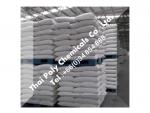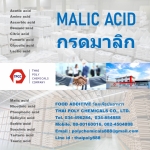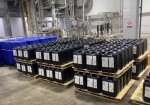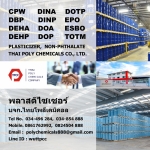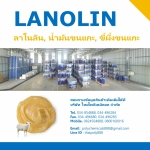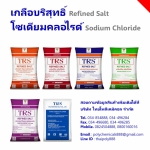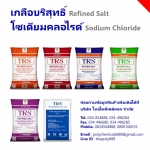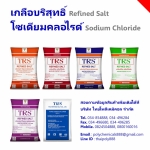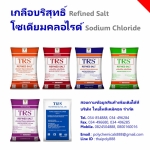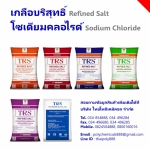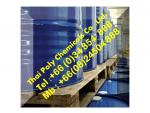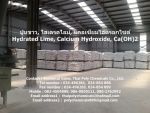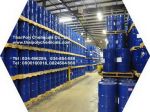Sodium Hydroxide 98% โซเดียมไฮดรอกไซด์ โซดาไฟเกล็ด โซดาไฟผลึก NaOH 98% |
฿1 |
|
ชื่อผู้ประกาศ : Thailandchemicals เบอร์โทรศัพท์ : 034854888, 034496284 โทรศัพท์มือถือ : 0824504888, 0800160016 ที่อยู่ : 36/5 ม.9 ต.นาดี อ.เมืองสมุทรสาคร ร้าน Thailand Chemicals |
นำเข้าและจำหน่าย โซเดียมไฮดรอกไซด์, โซดาไฟ, โซดาไฟเกล็ด, โซดาไฟผลึก, โซดาไฟ 50%, โซดาไฟ 98%, โซดาไฟน้ำ, Sodium Hydroxide, Caustic soda, NaOH liquid. NaOH flake, NaOH soulution, NaOH 50%, NaOH 98%, คอสติกโซดา, โซดาไฟเหลว
โซเดียมไฮดรอกไซด์, โซดาไฟ,
คอสติกโซดา, Sodium Hydroxide, Caustic Soda,NaOHโซดาแผดเผา, โซดาไฟ หรือ คอสติกโซดา (อังกฤษ:
caustic soda) พจนานุกรมฉบับราชบัณฑิตยสถาน พ.ศ. 2542 นิยามว่า คือ "สารประกอบชนิดหนึ่ง ชื่อ โซเดียมไฮดรอกไซด์ (NaOH)
เป็นของแข็งสีขาว ดูดความชื้นดีมาก ละลายน้ำได้ดี
ใช้ประโยชน์ในอุตสาหกรรมทำสบู่ ไหมเรยอง" โซดาไฟถูกใช้ในการผลิตเป็นผลิตภัณฑ์ต่าง ๆ ที่เกี่ยวข้องกับชีวิตประจำวัน และยังใช้ประโยชน์ได้อีกมากมาย เช่น ในการผลิตเยื่อและกระดาษ สบู่และผลิตภัณฑ์ซักฟอก เคมีภัณฑ์ การทำความสะอาด โรงกลั่นน้ำมัน การใช้งานทางอุตสาหกรรมโลหะ อุตสาหกรรมอาหาร ไหมเรยอง สิ่งทอ และอื่น ๆ การใช้สารเคมีแก้ปัญหาท่ออุดตัน สามารถหาซื้อได้ตามร้านค้าทั่วไป หรือร้านขายอุปกรณ์ซ่อมแซมบ้าน คุณลักษณะสารเคมีเป็นของแข็งสีขาว ไม่มีกลิ่น มีฤทธิ์เป็นด่าง ยิ่งเข้มข้นมากยิ่งมีฤทธิ์มาก ร้อน และสามารถกัดผิวหนังให้เปื่อยยุ่ยได้ในระยะเวลาเพียงแค่เสี้ยววินาที ผู้คนส่วนมากอาจจะไม่รู้ถึงคุณลักษณะของสารเคมี และการทำปฏิกิริยาทางเคมีดีพอ เมื่อนำไปใช้งานจริงทำให้เกิดปัญหาติดตามมาอย่างคาดไม่ถึง เช่น เวลาที่ท่ออุดตัน ก็จะไปซื้อโซดาไฟ มาเทใส่ลงไปในท่อที่อุดตัน (วิธีใช้งาน ควรใส่โซดาไฟในภาชนะก่อน ค่อย ๆ เติมน้ำแล้วคนให้ละลายให้หมดก่อนที่จะนำไปเทใส่ท่อระบายน้ำ เพื่อกันไม่ให้โซดาไฟไปเกาะผนังท่อเพิ่มการอุดตันอีก) การแก้ไขปัญหาลักษณะนี้ สามารถใช้ได้กับการอุดตันบางประเภทเท่านั้นเอง เช่น การอุดตันที่เกิดจากคราบไขมัน ประกอบด้วยโลหะโซเดียมและเบสไฮดรอกไซด์ ใช้ประโยชน์ในทางอุตสาหกรรมต่างๆ มากมาย เช่น อุตสาหกรรมกระดาษ น้ำดื่ม สบู่ และผงซักฟอก นอกจากนั้นยังใช้ปรับสภาพน้ำทิ้งที่มีฤทธิ์เป็นกรด ให้เป็นกลางก่อนปล่อยสู่แหล่งน้ำธรรมชาติอีกด้วย โซดาไฟบริสุทธิ์ มีลักษณะเป็นของแข็งสีขาว ที่พบได้บ่อยจะทำเป็นเม็ด โซดาไฟนี้ดูดความชื้นได้ดีมาก หากนำออกมาจากภาชนะบรรจุแล้วตั้งทิ้งไว้สักครู่มันจะดูดความชื้นจากอากาศ จากสภาพที่เป็นเม็ดแข็ง จะเริ่มเหลว เนื้อสารจะน้อยลง เพราะถูกเจือจางด้วยความชื้นนั่นเอง จึงควรเก็บโซดาไฟไว้ในขวดที่มีฝาปิดสนิท เมื่อเตรียมโซดาไฟบริสุทธิ์ให้เป็นสารละลายโดยการละลายน้ำ จะให้ความร้อนออกมาจึงต้องระมัดระวัง หากเตรียมความเข้มข้นสูงๆ ห้ามเตรียมในภาชนะพลาสติกเนื่องจากความร้อนที่เกิดจากการละลายด้วยน้ำ จะทำให้พลาสติกละลายได้ ความสามารถในการละลายของโซดาไฟจะลายได้ในตัวทำละลายที่มีขั้วได้อีกนอกจากน้ำ เช่น เอทานอล และเมทานอล ไม่สามารถละลายได้ใน อีเทอร์ หรือตัวทำละลายอื่นที่ไม่มีขั้ว โซดาไฟมีคุณสมบัติเป็นสารไอออนิก
ตัวอย่างปฏิกิริยาของโซดาไฟ
- ทำปฏิกิริยากับกรดได้ผลิตภัณฑ์เป็น
เกลือและน้ำดังสมการ
NaOH(aq) + HCl(aq) ? NaCl(aq) + H2O(l)
- ทำปฏิกิริยากับ
ออกไซด์ของกรด ใช้ประโยชน์ในการจับก๊าซที่เป็นกรด เช่น คาร์บอนได้ออกไซด์ หรือ
2 NaOH + CO2 ? Na2CO3 + H2O
- การแยกสลายด้วยไฟฟ้า
(Electrolysis) ในสภาวะการหลอมเหลวโซดาไฟ ได้ผลิตภัณฑ์เป็น
โลหะโซเดียม ก๊าซออกซิเจน และน้ำ
4 NaOH?H2O(l) ? 4 Na(l) + O2(g) + 6 H2O(g)
โชเดียมไฮดรอกไซด์ชนิดเหลว
นำมาใช้ในการผลิดเยื้อกระดาษสบู่ ผงซักฟอก เส้นใยทอผ้า ผงชูรส และน้ำมันปิโตรเลียม
นอกจากนี้ยังสามารถนำไปใช้ในอุตสาหกรรมผลิตยาง แก้ว แผ่นเหล็ก โพลีเมอร์และเรซิน
รวมทั้งอุตสาหกรรมการกลั่นน้ำมัน?โซเดียมไฮดรอกไซด์ชนิดเม็ด
นำมาใช้ในอุตสาหกรรมต่างๆ เช่นเดียวกับโชเดียมไฮดรอกไซด์ชนิดเหลว
?โชเดียมไฮดรอกไซด์ชนิดเกล็ด
นำมาใช้ในอุตสาหกรรมต่างๆ เช่นเดียวกับโชเดียมไฮดรอกไซด์ชนิดเหลว แต่เก็บรักษาและขนส่งได้สะดวกกว่า
Sodium hydroxide, also known as
caustic soda, or lye, is an inorganic compound with the chemical formula NaOH. It is a white solid and highly caustic metallic base and alkali salt which is available in pellets, flakes, granules, and as prepared solutions at a number of different concentrations. Sodium hydroxide forms an approximately 50% (by weight) saturated solution with water. Sodium hydroxide is soluble in water, ethanol and methanol. This alkali is deliquescent and readily absorbs moisture
Sodium hydroxide is used in many
industries, mostly as a strong chemical base in the manufacture of pulp and
paper, textiles, drinking water, soaps and detergents and as a drain cleaner.
Worldwide production in 2004 was approximately 60 million tonnes, while demand
was 51 million tonesProduction
Sodium hydroxide is industrially
produced as a 50% solution by variations of the electrolytic chloralkali
process. Chlorine gas is also produced in this process. Solid sodium hydroxide
is obtained from this solution by the evaporation of water. Solid sodium
hydroxide is most commonly sold as flakes, prills, and cast blocks.In 2004, world production was
estimated at 60 million dry metric tonnes of sodium hydroxide, and demand was
estimated at 51 million tonnes. In 1998, total world production was around 45
million tonnes. North America and Asia collectively contributed around 14
million tonnes, while Europe produced around 10 million tonnes. In the United
States, the major producer of sodium hydroxide is the Dow Chemical Company,
which has annual production around 3.7 million tonnes from sites at Freeport,
Texas, and Plaquemine, Louisiana. Other major US producers include OxyChem,
PPG, Olin, Pioneer Companies, Inc. (PIONA, which was purchased by Olin), and
Formosa. All of these companies use the chloralkali process.Historically sodium hydroxide is
produced by treating sodium carbonate with calcium hydroxide in a metathesis
reaction. (Sodium hydroxide is soluble while calcium carbonate is not.) This
process was called causticizing. Ca(OH)2(aq) + Na2CO3(s) ? CaCO3? + 2 NaOH(aq)
This process was superseded by the
Solvay process in the late 19th century, which was in turn supplanted by the
chloralkali process which we use today.Sodium hydroxide is also produced
by combining pure sodium metal with water. The byproducts are hydrogen gas and
heat, often resulting in a flame, making this a common demonstration of the
reactivity of alkali metals in academic environments; however, it is not
commercially viable, as the isolation of sodium metal is typically performed by
reduction or electrolysis of sodium compounds including sodium hydroxide.Sodium hydroxide is the principal
strong base used in the chemical industry. In bulk it is most often handled as
an aqueous solution, since solutions are cheaper and easier to handle. Sodium
hydroxide, a strong base, is responsible for most of these applications.
Another strong base such as potassium hydroxide is likely to yield positive results
as well.Overall 56% of sodium hydroxide
produced is used by the chemical industry, with 25% of the same total used by
the paper industry. Sodium hydroxide is also used for the manufacture of sodium
salts and detergents, for pH regulation, and for organic synthesis. It is used
in the Bayer process of aluminium production.Sodium hydroxide is used in many
scenarios where it is desirable to increase the alkalinity of a mixture, or to
neutralize acids.For example, sodium hydroxide is
used as an additive in drilling mud to increase alkalinity in bentonite mud
systems, to increase the mud viscosity, and to neutralise any acid gas (such as
hydrogen sulfide and carbon dioxide) which may be encountered in the geological
formation as drilling progresses.In the same industry, poor quality
crude oil can be treated with sodium hydroxide to remove sulfurous impurities
in a process known as caustic washing. As above, sodium hydroxide reacts with
weak acids such as hydrogen sulfide and mercaptans to give the non-volatile
sodium salts which can be removed. The waste which is formed is toxic and
difficult to deal with, and the process is banned in many countries because of
this. In 2006, Trafigura used the process and then dumped the waste in AfricaChemical pulping
Main article: Pulp (paper)
Sodium hydroxide is also widely
used in pulping of wood for making paper or regenerated fibers. Along with
sodium sulfide, sodium hydroxide is a key component of the white liquor
solution used to separate lignin from cellulose fibers in the kraft process. It
also plays a key role in several later stages of the process of bleaching the
brown pulp resulting from the pulping process. These stages include oxygen
delignification, oxidative extraction, and simple extraction, all of which
require a strong alkaline environment with a pH > 10.5 at the end of the
stages.Tissue digestion
In a similar fashion, sodium
hydroxide is used to digest tissues, such as in a process that was used with
farm animals at one time. This process involved placing a carcass into a sealed
chamber, then adding a mixture of sodium hydroxide and water (which breaks the
chemical bonds that keep the flesh intact). This eventually turns the body into
a liquid with coffee-like appearance, and the only solid that remains are bone
hulls, which could be crushed between one's fingertips. Sodium hydroxide is
frequently used in the process of decomposing roadkill dumped in landfills by animal
disposal contractors. Due to its low cost and availability, it has been used to
dispose of corpses by criminals. In Mexico, a man who worked for drug cartels
admitted disposing over 300 bodies with it.Dissolving amphoteric metals and
compoundsStrong bases attack aluminium.
Sodium hydroxide reacts with aluminium and water to release hydrogen gas. The
aluminium takes the oxygen atom from sodium hydroxide, which in turn takes the
oxygen atom from the water, and releases the two hydrogen atoms, The reaction
thus produces hydrogen gas and sodium aluminate. In this reaction, sodium
hydroxide acts as an agent to make the solution alkaline, which aluminium can
dissolve in. This reaction can be useful in etching, removing anodizing, or
converting a polished surface to a satin-like finish, but without further
passivation such as anodizing or alodining the surface may become degraded,
either under normal use or in severe atmospheric conditions.In the Bayer process, sodium
hydroxide is used in the refining of alumina containing ores (bauxite) to
produce alumina (aluminium oxide) which is the raw material used to produce
aluminium metal via the electrolytic Hall-H?roult process. Since the alumina is
amphoteric, it dissolves in the sodium hydroxide, leaving impurities less
soluble at high pH such as iron oxides behind in the form of a highly alkaline
red mud.See also: Ajka alumina plant
accidentOther amphoteric metals are zinc
and lead which dissolve in concentrated sodium hydroxide solutions to give
sodium zincate and sodium plumbate respectively.Esterification and transesterification
reagentSodium hydroxide is traditionally
used in soap making (cold process soap, saponification). It was made in the
nineteenth century for a hard surface rather than liquid product because it was
easier to store and transport.For the manufacture of biodiesel,
sodium hydroxide is used as a catalyst for the transesterification of methanol
and triglycerides. This only works with anhydrous sodium hydroxide, because
combined with water the fat would turn into soap, which would be tainted with methanol.
It is used more often than potassium hydroxide because it is cheaper and a
smaller quantity is needed.Sodium hydroxide is also being
used experimentally in a new technology to create synthetic gasoline.Food preparation
Food uses of sodium hydroxide
include washing or chemical peeling of fruits and vegetables, chocolate and
cocoa processing, caramel coloring production, poultry scalding, soft drink
processing, and thickening ice cream. Olives are often soaked in sodium
hydroxide for softening; Pretzels and German lye rolls are glazed with a sodium
hydroxide solution before baking to make them crisp. Owing to the difficulty in
obtaining food grade sodium hydroxide in small quantities for home use, sodium
carbonate is often used in place of sodium hydroxide.Specific foods processed with
sodium hydroxide include:The Scandinavian delicacy known as lutefisk
(from lutfisk, "lye fish").Hominy is dried maize (corn) kernels
reconstituted by soaking in lye-water. These expand considerably in size and
may be further processed by frying to make corn nuts or by drying and grinding
to make grits. Nixtamal is similar, but uses calcium hydroxide instead of
sodium hydroxide.Sodium hydroxide is also the chemical that
causes gelling of egg whites in the production of Century eggs.German pretzels are poached in a boiling
sodium carbonate solution or cold sodium hydroxide solution before baking,
which contributes to their unique crust.Lye-water is an essential ingredient in the
crust of the traditional baked Chinese moon cakes.Most yellow coloured Chinese noodles are made
with lye-water but are commonly mistaken for containing egg. Some methods of preparing olives involve
subjecting them to a lye-based brine.The Filipino dessert (kakanin) called kutsinta
uses a bit of lye water to help give the rice flour batter a jelly like
consistency. A similar process is also used in the kakanin known as pitsi-pitsi
or pichi-pichi except that the mixture uses grated cassava instead of rice
flour.Cleaning agent
Main article: Cleaning agent
Sodium hydroxide is frequently
used as an industrial cleaning agent where it is often called
"caustic". It is added to water, heated, and then used to clean
process equipment, storage tanks, etc. It can dissolve grease, oils, fats and
protein based deposits. It is also used for cleaning waste discharge pipes
under sinks and drains in domestic properties. Surfactants can be added to the
sodium hydroxide solution in order to stabilize dissolved substances and thus
prevent redeposition. A sodium hydroxide soak solution is used as a powerful
degreaser on stainless steel and glass bakeware. It is also a common ingredient
in oven cleaners.A common use of sodium hydroxide
is in the production of parts washer detergents. Parts washer detergents based
on sodium hydroxide are some of the most aggressive parts washer cleaning
chemicals. The sodium hydroxide based detergent include surfactants, rust
inhibitors and defoamers. A parts washer heats water and the detergent in a
closed cabinet and then sprays the heated sodium hydroxide and hot water at
pressure against dirty parts for degreasing applications. Sodium hydroxide used
in this manner replaced many solvent based systems in the early 1990s[citation
needed] when trichloroethane was outlawed by the Montreal Protocol. Water and
sodium hydroxide detergent based parts washers are considered to be an
environmental improvement over the solvent based cleaning methods. Sodium
hydroxide is used in the home as a type of drain opener to unblock clogged
drains, usually in the form of a dry crystal or as a thick liquid gel. The
alkali dissolves greases to produce water soluble products. It also hydrolyzes
the proteins such as those found in hair which may block water pipes. These
reactions are sped by the heat generated when sodium hydroxide and the other
chemical components of the cleaner dissolve in water. Such alkaline drain
cleaners and their acidic versions are highly corrosive and should be handled
with great caution. Sodium hydroxide is used in some relaxers to straighten
hair. However, because of the high incidence and intensity of chemical burns,
manufacturers of chemical relaxers use other alkaline chemicals in preparations
available to average consumers. Sodium hydroxide relaxers are still available,
but they are used mostly by professionals.A solution of sodium hydroxide in
water was traditionally used as the most common paint stripper on wooden
objects. Its use has become less common, because it can damage the wood
surface, raising the grain and staining the colour.Historical uses
Sodium hydroxide has been used for
detection of carbon monoxide poisoning, with blood samples of such patients
turning to a vermilion color upon the addition of a few drops of sodium
hydroxide.[20] Today, carbon monoxide poisoning can be detected by CO oximetry.APPLICATION
Caustic soda solution is used in
the production of paper pulp, soap, detergent,textiles, petroleum, cooking oil,
pharmaceuticals, rubber, glass, metal - plating,water purification , stain removal
, others.STORAGE CONDITION
Store in cool, dry,
well-ventilated area. Store away from incompatible materials such as strong
acids , nitroaromatic , nitroparaffinic or organohalogen compounds.
สอบถามข้อมูลเพิ่มเติมได้ที่
ฝ่ายขายThai Poly Chemicals Co., Ltd.
บริษัท ไทยโพลีเคมิคอล จำกัด
ที่อยู่36/5 ม.9 แขวง/ตำบลนาดี
เขต/อำเภอเมืองสมุทรสาคร
จังหวัดสมุทรสาคร รหัสไปรษณีย์74000Tel.: 034854888,
034496284
Fax.: 034854899,
034496285
Mobile: 0824504888,
0800160016
Website :
www.thaipolychemicals.comEmail1 : thaipolychemicals@hotmail.com
Email2 : info@thaipolychemicals.com
โซเดียมไฮดรอกไซด์98%causticโซดาไฟผลึกโซดาไฟเกล็ดsodiumโซดาไฟผงflakeโซดาไฟ98%soda

